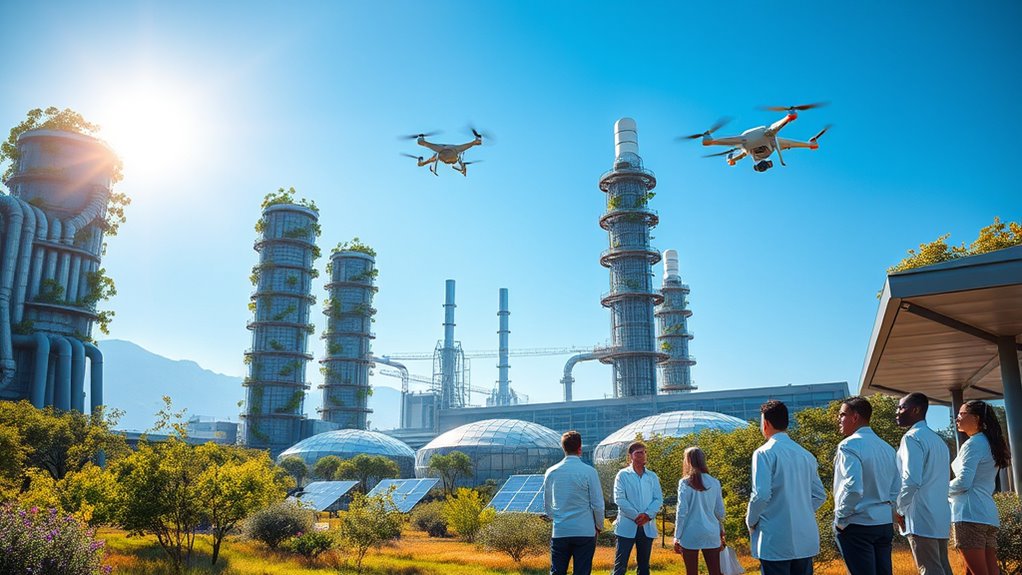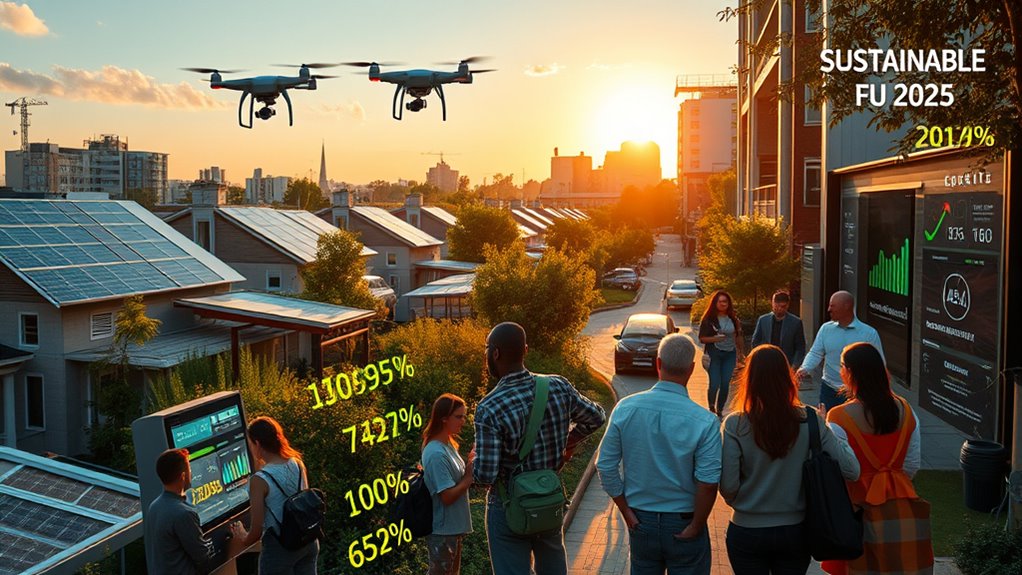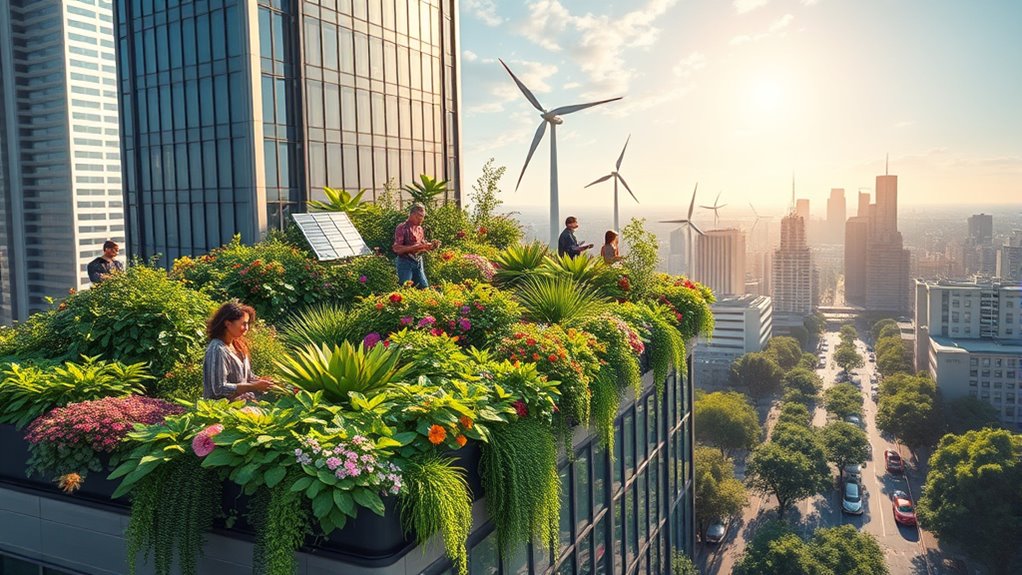By 2025, sustainability trends will focus on stricter ESG reporting standards and advanced carbon tracking technologies. You’ll see a rise in sustainable finance products and efforts to prevent greenwashing. The adoption of circular economy models and enhanced carbon capture strategies will become mainstream. AI will play a crucial role in sustainability initiatives, while standardized carbon credit methodologies gain traction. Long-term sustainability goals will also emerge, ensuring accountability and community engagement. Discover what’s next in this evolving landscape.
Key Takeaways
- Stricter ESG reporting standards will enforce transparency and accountability in corporate sustainability practices across industries by 2025.
- Mainstream adoption of advanced carbon tracking technologies will enhance emissions monitoring and inform decarbonization strategies effectively.
- The growth of sustainability-linked loans (SLLs) will incentivize companies to meet specific environmental and social performance targets, driving investment towards responsible practices.
- Circular economy models will gain traction, emphasizing waste elimination and resource efficiency through innovative business practices and technologies.
- Long-term sustainability goals will prioritize biodiversity conservation and community engagement in environmental decision-making, fostering resilient ecosystems and local stewardship.
Stricter ESG Reporting Standards

As companies face increasing pressure to demonstrate their commitment to sustainability, stricter ESG reporting standards are set to reshape the landscape in 2025.
The EU’s Corporate Sustainability Reporting Directive (CSRD) will make ESG reporting mandatory for large entities, moving away from voluntary practices. You’ll need to navigate these changes, as many countries are expected to adopt ISSB standards, ensuring global consistency in sustainability reporting. The increased focus on data transparency will help stakeholders better understand and evaluate corporate commitments to sustainability. Additionally, many organizations are integrating efficient payment solutions to streamline their financial tracking in relation to sustainability initiatives. To further enhance their sustainability efforts, businesses may also consider using air purifiers to improve indoor air quality and demonstrate a commitment to employee well-being.
The CSRD will mandate ESG reporting for large entities, marking a shift towards global consistency in sustainability practices.
In California, the new AB 1305 law will require compliance with specific disclosure requirements, affecting major corporations. Enhanced data transparency will be a focus, allowing for more accurate assessments of environmental impacts. Additionally, mandatory reporting under the EU’s CSRD will begin in 2025, emphasizing the need for businesses to adapt to these stringent regulations.
Regulatory oversight will also tighten, ensuring strict adherence to these evolving reporting obligations across EU member states and beyond.
Mainstream Carbon Tracking Technologies
Carbon tracking technologies are set to take center stage in 2025, revolutionizing how businesses measure and manage their emissions.
With AI leading the charge, you’ll find that tracking and optimizing carbon footprints will become more efficient and accurate. AI automates data collection and analysis, allowing you to predict decarbonization outcomes clearly. Furthermore, machine learning algorithms enhance the ability to analyze vast amounts of emissions data, leading to more informed decision-making. Additionally, risk management strategies can help businesses effectively navigate the complexities of emissions tracking and compliance. AI-driven education programs will also play a crucial role in equipping businesses with the necessary knowledge for effective emissions management.
Advanced algorithms will analyze unstructured supplier data, enhancing emissions tracking across complex supply chains. Moreover, tailored decarbonization strategies will emerge for various sectors, like manufacturing and logistics. As the carbon accounting market grows rapidly, reaching USD 102 billion by 2032, you’ll see increased adoption of innovative technologies, such as blockchain and IoT sensors, further supporting your sustainability goals.
Embrace these advancements to stay competitive and environmentally responsible.
Growth of Sustainable Finance Products

With businesses increasingly focused on carbon tracking technologies, the financial landscape is also evolving to support sustainability initiatives. You’ll find that ESG integration is becoming essential, with platforms like MSCI helping you direct investments toward responsible companies, promoting accountability. Sustainable bond issuance is on track to reach $1 trillion by 2025, bolstering investor confidence, especially with the EU Green Bond Standard in place. Proper planning around RMDs can help investors strategically align their portfolios with sustainable investments. High-quality sourcing from reputable producers is vital in ensuring the sustainability of investments. Sustainability-linked bonds are gaining traction, providing funding tied to achieving specific ESG goals. Additionally, impact investing is on the rise, allowing you to combine financial returns with meaningful social and environmental outcomes. As ESG assets grow, your investment strategy can align more closely with sustainable practices, driving positive change across industries. The increasing recognition of the financial and ethical imperative to align investments with sustainability goals is influencing investor priorities. To enhance your understanding, it’s important to explore IRA investment strategy that incorporates sustainable options, ensuring your portfolio reflects your values.
Expansion of Circular Economy Models

The expansion of circular economy models is transforming how businesses operate, enabling you to contribute to a more sustainable future.
By eliminating waste and pollution, companies focus on sustainable practices, which benefits both the environment and your community. You’ll see products designed for longevity, encouraging reuse and recycling. Additionally, the adoption of renewable energy technologies can significantly reduce the carbon footprint of production processes. For example, sustainable harvesting practices in foraging help preserve natural resources while promoting biodiversity. Furthermore, innovations such as heat pump technology provide energy-efficient solutions that align with sustainability goals.
As consumer awareness grows, demand for circular products skyrockets, pushing businesses to adopt innovations like Product-as-a-Service and sharing platforms. This shift aims to decouple economic growth from resource consumption, promoting a more sustainable approach to business.
Technological advances, such as AI and IoT, enhance resource management and boost efficiency. These emerging models not only extend product life but also turn waste into valuable resources, driving economic growth.
Embracing circularity allows you to play a vital role in fostering a more sustainable economic landscape.
Enhanced Carbon Capture Efficiency

As industries seek to reduce their environmental impact, enhanced carbon capture efficiency is becoming a game changer in the fight against climate change.
One of the most promising advancements is Direct Air Capture (DAC), which effectively removes CO2 from the atmosphere. With improved technology, DAC systems are now more efficient and cost-effective, allowing you to capture larger volumes of carbon while minimizing energy use. This means you can play a crucial role in lowering greenhouse gas emissions, especially as cross-border carbon credit transfers become more prevalent in global sustainability efforts. By investing in these innovative solutions, businesses not only meet sustainability goals but also enhance their reputation among consumers. Additionally, implementing proper maintenance of carbon capture systems ensures optimal performance and longevity. The tea industry, for instance, is increasingly adopting sustainable practices to mitigate climate change impacts on production. Furthermore, advanced technology in heat pumps can significantly reduce overall energy consumption, complementing carbon capture initiatives.
As you embrace enhanced carbon capture technologies, you’re contributing to a cleaner, healthier planet for future generations.
Let’s make a difference together!
Rise of Sustainability-Linked Loans

While companies increasingly focus on sustainability, the rise of sustainability-linked loans (SLLs) offers an innovative financing solution that rewards borrowers for meeting environmental and social performance targets.
Unlike green loans, SLLs aren’t restricted to specific projects and can be used for general corporate purposes. Guided by principles from organizations like the Loan Market Association, SLLs hinge on key performance indicators (KPIs) to measure success. Investments in sustainable initiatives often lead to enhanced brand reputation and customer loyalty. Additionally, businesses are increasingly recognizing the importance of diversifying investment portfolios with gold investments as a hedge against economic uncertainty. Furthermore, companies that embrace sustainability can benefit from improved risk assessment strategies, which help in identifying potential challenges and opportunities.
As of 2022, nearly C$2 trillion in SLLs have been issued, with half of European leveraged loans incorporating these features. SLLs incentivize borrowers to meet ambitious sustainability performance objectives, which enhances their attractiveness to companies striving for improved ESG outcomes.
Despite economic challenges in 2023, the demand for SLLs is expected to grow as companies increasingly integrate ESG outcomes into their financing strategies, making them essential in today’s corporate landscape.
Increased Focus on Greenwashing Prevention

With consumers increasingly aware of misleading claims, companies are prioritizing greenwashing prevention more than ever. Regulatory advancements, like the EU’s Green Claims Directive and updated FTC guidelines in the U.S., push for verified environmental labels and independent certifications. States such as California are implementing laws to back these claims, ensuring accountability. Enhanced transparency is key; vague terms are being replaced with specific, evidence-based claims, and supply chains undergo regular audits. Additionally, understanding filial responsibility laws can help companies navigate their obligations to stakeholders and ensure ethical practices. Developing a growth mindset helps companies adapt their strategies to meet these new demands. Third-party organizations, like B-Corp, provide credible certifications, while employee education fosters a culture of honesty. As consumer skepticism grows, businesses that commit to genuine sustainability practices won’t only comply with regulations but also earn trust and loyalty in an increasingly discerning market. To successfully navigate this landscape, companies must recognize and mitigate the risks of greenwashing tactics, which can undermine their sustainability efforts. Furthermore, as the global political climate shifts towards multilateral organizations, collaboration on sustainability initiatives will become increasingly vital for achieving long-term goals.
Adoption of AI in Sustainability Initiatives

The push for genuine sustainability in business practices has opened the door for innovative technologies like artificial intelligence (AI) to take center stage in sustainability initiatives. You can leverage AI to optimize energy use, significantly aiding decarbonization efforts by promoting renewable energy sources like solar and wind. By utilizing AI models, you can track emissions, reduce pollution, and improve industrial processes to minimize waste. AI also plays a crucial role in preserving biodiversity, monitoring ecosystems, and ensuring sustainable resource management. Moreover, its capabilities in resource allocation enhance operational efficiency, supporting a circular economy by promoting material reuse. With improved predictive modeling for climate patterns, AI empowers you to develop effective mitigation strategies for a sustainable future. Additionally, the Coalition for Environmentally Sustainable AI aims to encourage AI initiatives for environmental benefits, highlighting the importance of collaboration among various stakeholders. Furthermore, data analytics can be applied in sustainability efforts to identify trends and optimize resource usage effectively. This shift toward AI integration is essential for addressing the complex challenges posed by climate change and resource depletion.
Standardized Carbon Credit Methodologies

As businesses increasingly commit to sustainability, standardized carbon credit methodologies play a crucial role in ensuring the integrity and effectiveness of carbon markets. These methodologies, guided by principles like the Core Carbon Principles (CCPs), emphasize transparency and additionality, which are vital for high-quality carbon credits. With stricter environmental regulations on the rise, the demand for standardized systems grows, reducing market fragmentation and improving efficiency. Clear standards not only simplify transactions but also enhance trust among stakeholders. Moreover, international collaboration and the use of artificial intelligence in data analysis are helping optimize carbon sequestration efforts. Additionally, the establishment of crediting programs enhances the verification process to confirm avoided GHG emissions or improved removals.
Long-Term Sustainability Goals Beyond 2030

While many organizations focus on immediate sustainability efforts, long-term sustainability goals beyond 2030 are crucial for ensuring a resilient future. You’ll need to prioritize biodiversity conservation and ecosystem restoration, enhancing the health of our planet. Implementing sustainable land use practices will help balance human needs with environmental integrity. Integrating indigenous rights into conservation strategies will honor traditional knowledge and support equity. Ensuring participatory spatial planning can significantly reduce biodiversity loss while fostering community engagement in environmental decisions. In urban planning, incorporating green spaces and renewable energy will improve both biodiversity and community well-being. You should also embrace technological innovations like clean energy solutions and digital monitoring tools. By focusing on these long-term strategies, you can create a sustainable environment that benefits future generations and mitigates climate change impacts effectively.
Frequently Asked Questions
How Can Individuals Contribute to Sustainability Efforts by 2025?
You can contribute to sustainability efforts by adopting simple lifestyle changes.
Start using sustainable transportation like biking or public transit to reduce your carbon footprint.
Embrace a zero waste lifestyle by composting and choosing reusable products over single-use plastics.
Engage in community projects or plant trees to support local ecosystems.
Additionally, shop secondhand to lessen demand for new items.
Every small action you take can collectively make a significant impact on our planet’s health.
What Industries Will Be Most Affected by Sustainability Trends?
Isn’t it fascinating how industries evolve? The energy sector’s shifting towards renewables, while manufacturing embraces circular economy principles.
You’re seeing finance adapt to stricter ESG regulations, making sustainability a priority.
Meanwhile, technology’s revolutionizing waste management and resource optimization, pushing companies to innovate.
As these sectors transform, your choices as a consumer and professional can significantly influence their paths.
Embrace these changes, and you’ll be part of a larger movement towards sustainability.
How Can Small Businesses Implement Circular Economy Practices?
To implement circular economy practices, start by assessing your waste stream and identifying opportunities for reduction and reuse.
Collaborate with suppliers to create closed-loop systems that minimize waste.
Consider offering products as services or establishing take-back programs to encourage recycling.
Engage your customers in sustainability initiatives, fostering loyalty while promoting resource efficiency.
Lastly, prioritize sustainable materials and design durable products to enhance longevity and reduce environmental impact, ultimately benefiting your bottom line.
What Role Do Consumers Play in Shaping Sustainability Trends?
You’re the heartbeat of sustainability trends, pulsing through the marketplace with your choices.
As a consumer, your preferences shape brands and their practices; you’re not just buying products; you’re casting votes for a greener future.
By prioritizing sustainable options, you encourage companies to embrace eco-friendly practices.
Your desire for transparency and ethical sourcing drives change, making brands rethink their strategies.
In this dance of demand and supply, you lead the way towards a sustainable world.
How Will Sustainability Trends Impact Job Markets and Employment Opportunities?
Sustainability trends will significantly impact job markets and employment opportunities.
You’ll see a surge in demand for green skills, with employers prioritizing expertise over traditional qualifications. Roles in renewable energy and environmental stewardship will grow, offering diverse career paths.
As companies adopt technology-driven solutions, jobs in data analysis and AI will emerge.
Embracing remote work can also increase talent availability, making sustainability careers more accessible and appealing to a broader audience.
Conclusion
As you navigate the landscape of sustainability in 2025, you’ll find that these trends are not just ripples in a pond but tidal waves of change. Embracing stricter ESG standards and innovative technologies will empower you to make impactful choices. By staying ahead of greenwashing and supporting circular economies, you can plant seeds for a healthier planet. Remember, each step you take today paves the path for a brighter, greener tomorrow. Let’s make sustainability a living, breathing reality!









